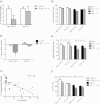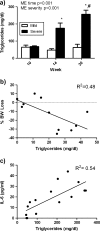The effect of exercise on IL-6-induced cachexia in the Apc ( Min/+) mouse
- PMID: 22476915
- PMCID: PMC3374019
- DOI: 10.1007/s13539-011-0047-1
The effect of exercise on IL-6-induced cachexia in the Apc ( Min/+) mouse
Abstract
Background: Cachexia involves unintentional body weight loss including diminished muscle and adipose tissue mass and is associated with an underlying disease. Systemic overexpression of IL-6 accelerates cachexia in the Apc(Min/+) mouse, but does not induce wasting in control C57BL/6 mice. With many chronic diseases, chronic inflammation and metabolic dysfunction can be improved with moderate exercise. A direct effect of regular moderate exercise on the prevention of IL-6-induced cachexia in the Apc(Min/+) mouse has not been investigated. The purpose of this study was to assess the effects of exercise on the development of cachexia in the Apc(Min/+) mouse.
Methods: Mice were randomly assigned to moderate treadmill exercise (18 m/min, 1 h, 6 days/week, 5% grade) or cage control (CC) groups from 6 to 14 weeks of age. At 12 weeks of age, mice were electroporated with either IL-6-containing or control plasmid into the quadriceps muscle. Mice were killed after 2 weeks of systemic IL-6 overexpression or control treatment.
Results: IL-6 overexpression induced an 8% loss in body weight in CC mice, which was significantly attenuated by exercise. IL-6 overexpression in CC mice increased fasting insulin and triglyceride levels, which were normalized by exercise, and associated with increased oxidative capacity, an induction of AKT signaling, and a repression of AMPK signaling in muscle. These exercise-induced changes occurred despite elevated inflammatory signaling in skeletal muscle.
Conclusion: We conclude that moderate-intensity exercise can attenuate IL-6-dependent cachexia in Apc(Min/+) mice, independent of changes in IL-6 concentration and muscle inflammatory signaling. The exercise effect was associated with improved insulin sensitivity and improved energy status in the muscle.
Figures











Similar articles
-
Sex differences in the relationship of IL-6 signaling to cancer cachexia progression.Biochim Biophys Acta. 2015 May;1852(5):816-25. doi: 10.1016/j.bbadis.2014.12.015. Epub 2014 Dec 30. Biochim Biophys Acta. 2015. PMID: 25555992 Free PMC article.
-
Interleukin-6 and cachexia in ApcMin/+ mice.Am J Physiol Regul Integr Comp Physiol. 2008 Feb;294(2):R393-401. doi: 10.1152/ajpregu.00716.2007. Epub 2007 Dec 5. Am J Physiol Regul Integr Comp Physiol. 2008. PMID: 18056981
-
The regulation of skeletal muscle protein turnover during the progression of cancer cachexia in the Apc(Min/+) mouse.PLoS One. 2011;6(9):e24650. doi: 10.1371/journal.pone.0024650. Epub 2011 Sep 19. PLoS One. 2011. PMID: 21949739 Free PMC article.
-
Exercise as an anti-inflammatory therapy for cancer cachexia: a focus on interleukin-6 regulation.Am J Physiol Regul Integr Comp Physiol. 2020 Feb 1;318(2):R296-R310. doi: 10.1152/ajpregu.00147.2019. Epub 2019 Dec 11. Am J Physiol Regul Integr Comp Physiol. 2020. PMID: 31823669 Review.
-
Molecular therapeutic strategies targeting pancreatic cancer induced cachexia.World J Gastrointest Surg. 2018 Dec 27;10(9):95-106. doi: 10.4240/wjgs.v10.i9.95. World J Gastrointest Surg. 2018. PMID: 30622678 Free PMC article. Review.
Cited by
-
Mitochondrial Dysfunction as an Underlying Cause of Skeletal Muscle Disorders.Int J Mol Sci. 2022 Oct 26;23(21):12926. doi: 10.3390/ijms232112926. Int J Mol Sci. 2022. PMID: 36361713 Free PMC article. Review.
-
Exercise training counteracts urothelial carcinoma-induced alterations in skeletal muscle mitochondria phospholipidome in an animal model.Sci Rep. 2019 Sep 17;9(1):13423. doi: 10.1038/s41598-019-49010-6. Sci Rep. 2019. PMID: 31530825 Free PMC article.
-
mTOR and Tumor Cachexia.Int J Mol Sci. 2018 Jul 30;19(8):2225. doi: 10.3390/ijms19082225. Int J Mol Sci. 2018. PMID: 30061533 Free PMC article. Review.
-
Impact of Cancer Cachexia on Cardiac and Skeletal Muscle: Role of Exercise Training.Cancers (Basel). 2022 Jan 11;14(2):342. doi: 10.3390/cancers14020342. Cancers (Basel). 2022. PMID: 35053505 Free PMC article. Review.
-
The IL-6 Paradox: Context Dependent Interplay of SOCS3 and AMPK.J Diabetes Metab. 2013 May 24;Suppl 13:10.4172/2155-6156.S13-003. doi: 10.4172/2155-6156.S13-003. J Diabetes Metab. 2013. PMID: 24244888 Free PMC article.
References
-
- Tisdale MJ. The ‘cancer cachectic factor’. Support Care Cancer. 2003;11:73–78. - PubMed
Grants and funding
LinkOut - more resources
Full Text Sources
Molecular Biology Databases

